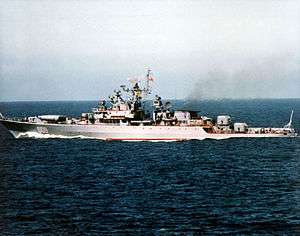Soviet frigate Retivyy
Retivyy (Russian: Ретивый, “Ardent”) was a Soviet Navy 1135 Burevestnik-class Guard Ship (Сторожевой Корабль, SKR) or Krivak-class frigate.
 Retivyy on 23 December 1985. | |
| History | |
|---|---|
| Name: | Retivyy |
| Namesake: | Russian for Ardent |
| Builder: | A.A. Zhdanov, Leningrad |
| Yard number: | 712 |
| Laid down: | 12 June 1974 |
| Launched: | 14 August 1976 |
| Commissioned: | 28 December 1976 |
| Decommissioned: | 4 August 1995 |
| Fate: | Scrapped |
| General characteristics | |
| Class and type: | Project 1135 Burevestnik frigate |
| Displacement: | 2,835 tonnes (2,790 long tons; 3,125 short tons) standard, 3,190 tonnes (3,140 long tons; 3,520 short tons) full load |
| Length: | 123 m (404 ft) |
| Beam: | 142 m (466 ft) |
| Draft: | 4.5 m (15 ft) |
| Propulsion: | 2 shaft; COGAG; 2 x M-8K gas-turbines, 34,000 shp (25,000 kW); 2 x M-62 gas-turbines (cruise), 12,000 shp (8,900 kW) |
| Speed: | 32 knots (59 km/h) |
| Range: | 4,000 nmi (7,408 km) at 14 knots (26 km/h) |
| Complement: | 23 officers, 169 men |
| Sensors and processing systems: | MR-310A Angara-A air/surface search radar, Volga navigation radar, Don navigation radar, MG-332 Titan-2, MG-325 Vega, 2 MG-7 Braslet and MGS-400K sonars |
| Electronic warfare & decoys: | PK-16 ship-borne decoy dispenser system |
| Armament: |
|
Design
Displacing 2,835 tonnes (2,790 long tons; 3,125 short tons) standard and 3,190 tonnes (3,140 long tons; 3,520 short tons) full load, Retivyy was 123 m (404 ft) in length.[1] Power was provided by a combination of two 17,000 horsepower (13,000 kW) M8K and two 6,000 horsepower (4,500 kW) M62 gas turbines, driving two fixed pitch screws, for a design speed of 32 knots (59 km/h).[1]
The ship was designed for anti-submarine warfare around four URPK-4 Metel missiles (NATO reporting name SS-N-14 'Silex'), backed up by 533 mm (21 in) torpedoes and a pair of RBU-6000 213 mm (8 in) anti-submarine rocket launchers.[2]
Service
Launched on 14 August 1976. Retivyy was accepted into the Pacific Fleet on 5 February 1977 as part of the 173th Brigade and operated in the Atlantic, Indian and Pacific Oceans.[3] On 30 October 1978, the ship participated in the search for the crew of the Lockheed P-3 Orion AF 586 from VP-9 that had crashed off the coast of the Kamchatka Peninsula. 1979 saw operations in the Indian Ocean with Razumnyy and Rezkiy, along with Project 641 submarines B-33 and B-112. In 1981 the vessel joined with Petropavlovsk, Rezkiy, submarine K-201 and the tanker Irkut for service off the west coast of the United States. Retivyy underwent anti-submarine training with Razumnyy in 1988. The ship was decommissioned on 4 August 1995 and sold to a South Korean company for scrap.[3]
Pennant numbers
| Pennant Number[1] | Date |
|---|---|
| 591 | |
| 217 | |
| 601 | 1979 |
| 616 | 1981 |
| 609 | 1984 |
| 628 | 1987 |
| 602 | 1990 |
| 670 | 1990 |
| 605 | 1995 |
References
- "Guard Ships Project 1135". Russian Ships. 2016. Retrieved 23 February 2016.
- Baker, A. D. (2002). The Naval Institute Guide to Combat Fleets of the World 2002-2003. Annapolis: Naval Institute Press. pp. 637–638.
- Holm, Michael. "Project 1135 Krivak I class". Soviet Armed Forces 1945–1991. Retrieved 23 February 2017.